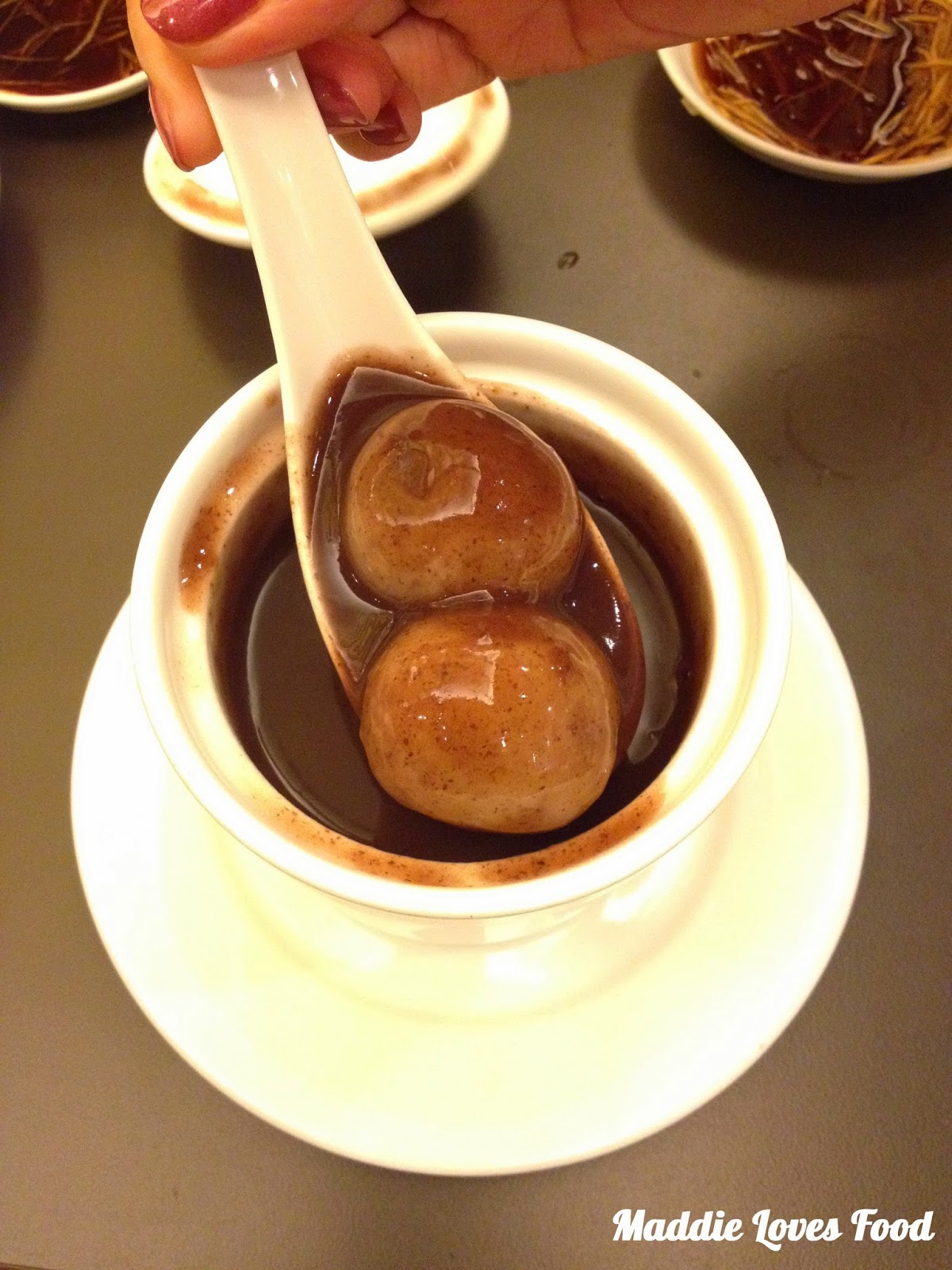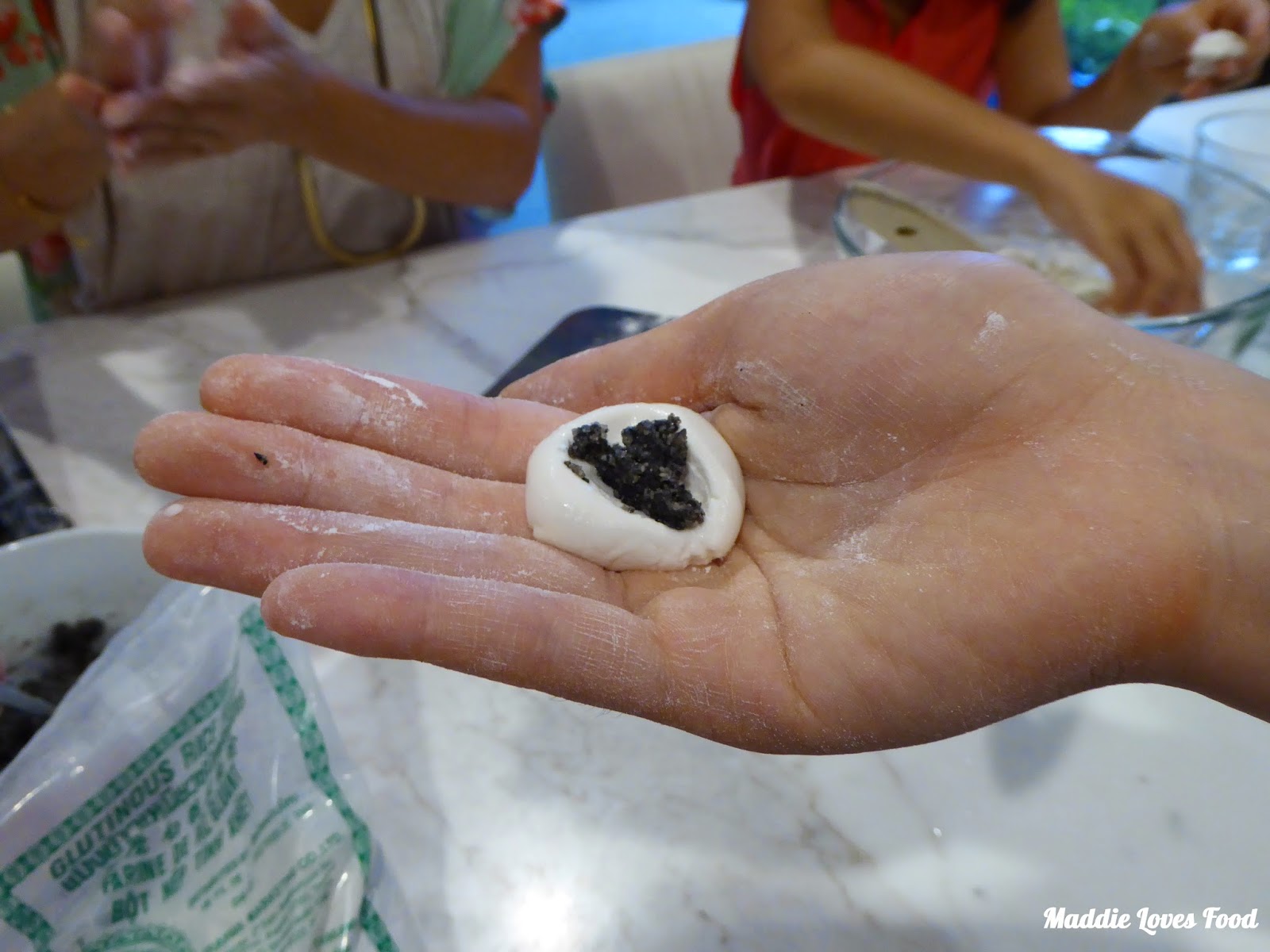Black Sesame Tong Yuan
Friday, March 20, 2015
Imagine if someone told you that all the best features of Asian sweets existed in a single dessert. The sticky, chewy texture of mochi, the roasted aroma of black sesame, ginger's signature hot zing, and the warm fulfilment of a sweet dessert soup, melded together to create what encompasses the pinnacle of everything that I love about Asian cuisine.
Chinese New Year,
for many Chinese families, is a celebration bigger than Christmas. It's a time
when multiple generations get together, exchange well wishes, and gather to eat a
banquet of traditional, well-loved foods which are destined to give good
luck for the new year.
This year we
embraced Chinese New Year wholeheartedly, decorating the walls with cute red
and gold Chinese couple figures, hanging a beautiful red velvet lantern above
our front door, and organising a family get together around a huge new year
feast at our place.
One of the traditional foods eaten at Chinese New Year is Tong Yuan (pronounced in Cantonese as tong yoon): small, sticky glutinous rice dumplings filled with an oozing paste of black sesame or peanuts and served in a sweet, hot ginger soup. They're traditionally eaten on the last day of the new year celebrations, with everyone coming together to make the miniature dumplings a symbol of family reunion, although they can be eaten any time of the year.
One of the traditional foods eaten at Chinese New Year is Tong Yuan (pronounced in Cantonese as tong yoon): small, sticky glutinous rice dumplings filled with an oozing paste of black sesame or peanuts and served in a sweet, hot ginger soup. They're traditionally eaten on the last day of the new year celebrations, with everyone coming together to make the miniature dumplings a symbol of family reunion, although they can be eaten any time of the year.
Tong Yuan at Din Tai Fung, Malaysia
I had my first taste
of these sticky rice dumplings at Din Tai Fung on a family trip to
Malaysia, and have fallen in love with them every since. They were filled with
a sweet, savoury filling of black sesame, my favourite flavour, in a thick,
deep maroon red bean soup. The chewy, sticky white skin, with its unctuous deep
black interior, was love at first bite, and I've had my heart on making them
ever since.
There are 3 main
components to making tong yuan: the sweet
ginger broth, the sweet filling, and the glutinous rice dough for the dumpling skin.
They're a treat to make, and may be easily prepared beforehand. Perhaps the
only fiddly part is rolling and filling the tong
yuan, as the dough can get very sticky if over-handled and just the
right amount of filling must be enclosed so that they don't burst when boiled.
Glutinous rice flour, contrary to what the name suggests, doesn't contain any gluten at all. Rather, the 'glutinous' description comes from the sticky texture it takes on when cooked. Both black sesame seeds and glutinous rice flour can be bought from all Asian grocery stores. Don't you just love wandering around in Asian grocery stores? There's just so many wondrous items to ponder over! Or is that just me?
Glutinous rice flour, contrary to what the name suggests, doesn't contain any gluten at all. Rather, the 'glutinous' description comes from the sticky texture it takes on when cooked. Both black sesame seeds and glutinous rice flour can be bought from all Asian grocery stores. Don't you just love wandering around in Asian grocery stores? There's just so many wondrous items to ponder over! Or is that just me?
The dough is formed by mixing glutinous rice flour with water until it
forms a smooth, dry dough. For each dumpling, pick off a small amount of dough,
roll it into a ball and flatten slightly so that a small amount of past can be
placed in and enclosed like a little pocket. Once made, the best way to store
them is on a flat plate dusted in a little of the rice flour to prevent them
from sticking. It's best to cook them straight away so that they don't dry out,
but I'm sure that placing a slightly damp tea towel on top will allow you to
make them a little in advance. Alternatively they can be frozen at this stage
for cooking later on.
Preparing the ginger syrup
Ginger syrup after reduction
The ginger soup consists of boiling sugar in water to make a syrup, then adding freshly
pounded ginger pieces and leaving them to simmer so that they take on the lovely heat of the ginger. Once flavoured, the syrup can then be
diluted by adding more water to make a less sweet soup, or left as it is. This freezes well, too.
Black sesame paste
Black sesame is one
of my favourite Asian flavours, and the paste for the filling is made by toasting and
grinding black sesame seeds, then mixing them with butter and sugar. The
resulting paste hardens considerably when refridgerated, but this helps make
filling the dumplings easier. I found that after making the full batch of
dumplings, half the paste was still leftover, which probably meant that they
could've been a little bit bigger, or filled more. However, this ended up being frozen for future tong yuan cravings ;).
The tong yuan can be made to any size you fancy;
our were about the diameter of a 20 cent coin. We were scared of filling them too much at first, as
the first few were too large and weren't properly sealed, however as we
progressed we became more familiar with the right size and feel of each
dumpling. Practise makes perfect!
Boiling the Tong Yuan
The little balls
were then boiled in a large pot of water, in two or three batches to allow
enough room for them to float about without sticking to each other. The best
indication that they're ready is when they float up to the surface, then you
can scoop them out and place directly into a bowl of the ginger soup, as
leaving them without any liquid once cooked will result in them sticking
together.
I could honestly eat
bowls and bowls of these round balls of sticky goodness. There is something
just so satisfying about biting your teeth into the chewy, sticky skin and relishing the aromatic, toasty sesame on your tastebuds. It's made a
whole lot better with the addition of a clear ginger soup; the sharp heat of
the ginger cutting through the sweetness of the brown liquid gold, and the
alluring sight of the mismatched, translucent white balls floating in the
golden clarity of the soup. A match made in heaven.
Our Chinese New Year
Feast was not all about the dessert, though. Our aunt, an avid cook and
healthy-cooking entrepreneur (see her quest into gluten-free, preservative-free Asian
cooking here), made a whole,
slow-roasted pork belly, flavoured with sweet apple and onion and finished off
with the most wonderful crackling.
Roast Pork Belly with Crackling
She also whipped up a wonderful, fresh Sang Choy Bao with the added surprise ingredient of diced broccoli stem, which added a lovely sweet crunch to each bite.
Sang Choy Bao
My Grandfather arrived proudly boasting cans of tinned abalone,
which he made into a dish with stir-fried lettuce and rich, plump dried Shiitake
mushrooms. I'd never heard of canned abalone before this; these were miniature and sweet, very easy to eat whole.
Baby Abalone with Shiitake Mushrooms and Stir-fried Lettuce
We'd prepared our
favourite Peking duck pancakes and Dad made the quintessential dish of stir-fried
noodles with Char Siu, snow peas, bean sprouts and tofu puffs. Noodles, traditionally eaten during Chinese New Year Celebrations, symbolise longevity for the new year.
DIY Peking Duck Pancakes
Stir-fried Hokkein noodles with Char Siu and Snow Peas
It was a night of
fabulous family feasting which left our bellies full and faces smiling the
whole night. But not until we'd eaten dessert!
Black Sesame Tong Yuan Recipe
Recipe adapted from Rasa Malaysia
Ingredients:
Ginger syrup
- 5 cups water
- 1 cup sugar (add less if you'd like the syrup less sweet)
- 100g ginger, peeled and pounded with knife to release aroma (I used a mixture of old and young ginger)
- 1/2 teaspoon sweet osmanthus (optional)
Dough
- 225g Glutinous rice flour (sticky rice flour)
- 3/4 cup water
Filling
- 1/4 cup black sesame seeds
- 1/4 cup sugar
- 55g butter, melted
Method:
Preparation of ginger syrup and black sesame paste
- Bring water to the boil in a large saucepan. Add ginger and boil for 10-15 minutes until fragrant.
- Add sugar and osmanthus, boil for 5 minutes, then turn heat down and simmer for around 15 minutes or until liquid has reduced to 4 cups. Take off the heat and reserve for serving dumplings.
- Toast sesame seeds in a small saucepan until fragrant. Take off the heat as soon as they begin to small aromatic, as they can burn quickly, take off the heat, transfer to a small bowl and leave to cool slightly. Grind in a food processor or mortar and pestle until fine, then mix in melted butter and sugar until a thick paste forms.
- Place glutinous rice flour into a large bowl. Add water and mix until smooth and the dough resembles the texture of play dough.
- Prepare a large, flat dish by sprinkling with a little bit of extra glutinous rice flour. This will prevent the tong yuan from sticking together. Take black sesame paste out of the fridge when ready to begin making tong yuan.
For the Tong Yuan
- Bring a large pot of water to the boil and reheat ginger syrup if necessary.
- Using lightly floured hands, pinch off a 20 cent sized ball of dough and roll into a ball. If you'd like them a little larger, pinch off a ping-pong-sized ball. Flatten slightly using in your palm, then place a 1/4 teaspoon of the black sesame paste into the centre of the flattened dough. Using your palm, push edges up and around to enclose filling and seal the dumpling. Roll back into a ball shape and place into prepared floured dish. Take care to seal each dumpling completely, otherwise they may burst upon boiling. Repeat until all dough is used up.
- Place Tong Yuan into the boiling water in two or three batches; boil until they float to the top. Once floating, transfer to a bowl of prepared ginger syrup using a slotted spoon. Alternatively, place into a bowl of hot water if preferred. If you have any broken or slightly wonky dumplings, cook them once all the others have been boiled. This way, you don't have to waste them or ruin the water.
- Enjoy immediately!






























0 comments